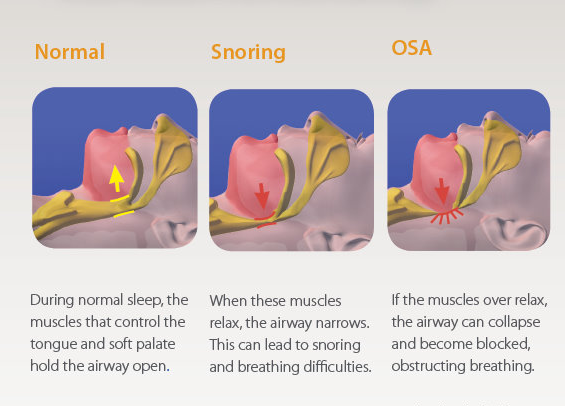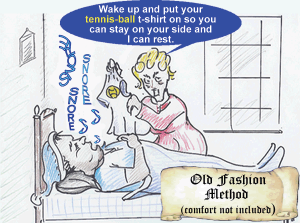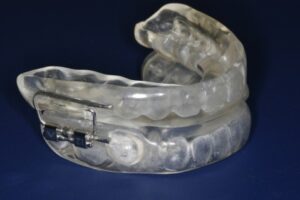
Sleep Disorders
Are you tired in the morning and during the day, even after you slept all night?
Has your bed partner noticed that you snore loudly or make chocking noise during sleep?
Do you fall asleep during the day at work or meeting or in the car when you don’t mean to?
If you answered “YES” to any of the above questions, then you may have Obstructive Sleep Apnea
Introduction
Sleep is a behavioral state that is a natural part of every individual’s life. We spend about one third of our lives asleep. It is not normal for a person to be sleepy at times when he or she expects to be awake. During sleep normally air moves through the throat, in and out of the lungs at regular rhythm.
Sleep apnea is a serious, potentially life-threatening condition that is far more common than generally understood and it can affect a person’s ability to safely perform normal daily activities and can affect long term health. It occurs in all age groups and both genders but it is more common in men, although it may be under-diagnosed in women. Other risk factors include middle and older age, being overweight or obese, and having a small throat or deformity in upper airway. It estimates that OSA affects 4 – 7 % of middle age and 70% of clinically obese patients. Early recognition and treatment of sleep apnea is important.

What is obstructive sleep apnea?
Obstructive sleep apnea (OSA) is a common sleep disorders. Apnea means being without breathe. “Obstruction Sleep Apnea” is characterized as a repetitive upper airway obstruction during sleep because of narrowing upper airway. In most people, this narrowing does not affect breathing. In others, it can cause snoring, sometimes with reduced or completely blocked airflow. A completely blocked airway without airflow is called an obstructive apnea. Partial obstruction with diminished airflow is called a hypopnea. A person may have apnea and hypopnea during sleep. Repetitive reduction in blood oxygenation and increase in carbon dioxide during apnea and hypopnea may eventually increase the risk of:
High blood pressure.
Strain on the cardiovascular system.
Risk of heart attack & irregular heart beat
Risk of stroke.
Daytime sleepiness
Increased risk of motor vehicle and work accidents
What are the risk factors for sleep apnea?
Increase with age – OSA occurs at all ages, but it is more common in middle and older age adults
Male sex. OSA is two times more common in men, especially in middle age.
The more obese a person is, the more likely they are to have OSA
Sedation from medication or alcohol interferes with the ability to awaken from sleep and can lengthen periods of apnea (no breathing), with potentially dangerous consequences.
Abnormality of the airway:
Structure abnormalities such as short fat neck and small lower jaw.
Upper airway narrowing such as large tonsils/adenoids, long uvula, and large tongue

What are the different types of sleep apnea?
Obstructive sleep apnoea (OSA) is caused by a blockage of the airway, usually when the soft tissue in the rear of the throat collapses and closes during sleep.
In central sleep apnoea, the airway is not blocked but the brain fails to signal the muscles to breathe.
Mixed apnoea, as the name implies, is a combination of the two. With each apnoea event, the brain briefly arouses people with sleep apnoea in order for them to resume breathing, but consequently sleep is extremely fragmented and of poor quality.
What are the signs and symptoms of sleep apnea?
Excessive daytime sleepiness
Nightly snoring interrupted by pauses in breathing
Falling asleep when you shouldn’t – at work, while driving, etc.
Loss of energy, fatigue
Choking and gasping during sleep
Restless sleep
High blood pressure
Neck size greater than 17” in men, 16” in women
Overweight
Depression
Trouble concentrating
Irritability
Forgetfulness
Morning headaches
Sexual dysfunction
How is sleep apnea diagnosed?
Nocturnal polysomnography is the gold standard for diagnosing obstructive sleep apnea.



How is sleep apnea treated?
Sleep apnea is best treated by a knowledgeable sleep medicine specialist. The goal of treatment is to maintain an open airway during sleep. Effective treatment will eliminate the symptoms of sleep disturbance; long-term health consequences are also reduced. Most treatments require nightly use. The challenge for the clinician and the patient is to select an effective therapy that is appropriate for the patient’s problem and that is acceptable for long term use.
Adjust sleep position
Weight loss
Avoid alcohol and other sedatives
Dental devices
Surgical treatment.
Surgery for snoring is a treatment of last resort and should only be considered if the simple non-surgical alternatives have been tried and failed. Before embarking on palatal surgery you should be sure that the snoring originates from the palate as opposed to the base of the tongue.
If you have nasal abnormalities these should also be addressed before contemplating palatal surgery.
The aim of palatal surgery is to reduce or stop the collapsibility of the oropharyngeal segment (area around the throat). This is usually done by reducing the amount of soft palate and/or removing the tonsils. Surgery is also undertaken to remove the chief vibratory tissue (the uvula).
Some surgeons advocate sleep nasendoscopy before surgery is undertaken to determine the level of obstruction. Here the patient is sedated to a state of sleep. The surgeon can then examine the upper airway through a narrow flexible endoscope to see where the collapsing is occurring. This procedure however is not widely available as it is time consuming and costly.

Continuous positive airway pressure (CPAP)
the most effective treatment for sleep apnea uses air pressure from a mechanical device to keep the upper airway open during sleep. A CPAP (continuous positive airway pressure) device uses an air-tight attachment to the nose, typically a mask, connected to a tube and a blower which generates the pressure. Devices that fit comfortably into the nasal opening, rather than over the nose, are also available. CPAP should be used any time the person sleeps (day or night).
The CPAP device is usually used for the first time in the sleep lab, where a technician can adjust the pressure and select the best equipment to keep the airway open. Alternatively, an “auto” device with a self-adjusting pressure feature, provided with proper education and training can get treatment started without another sleep test. While the treatment may seem uncomfortable, noisy, or bulky at first, most people accept the treatment after experiencing better sleep. However, difficulty with mask comfort and nasal congestion prevent up to 50 percent of people from using the treatment on a regular basis.
